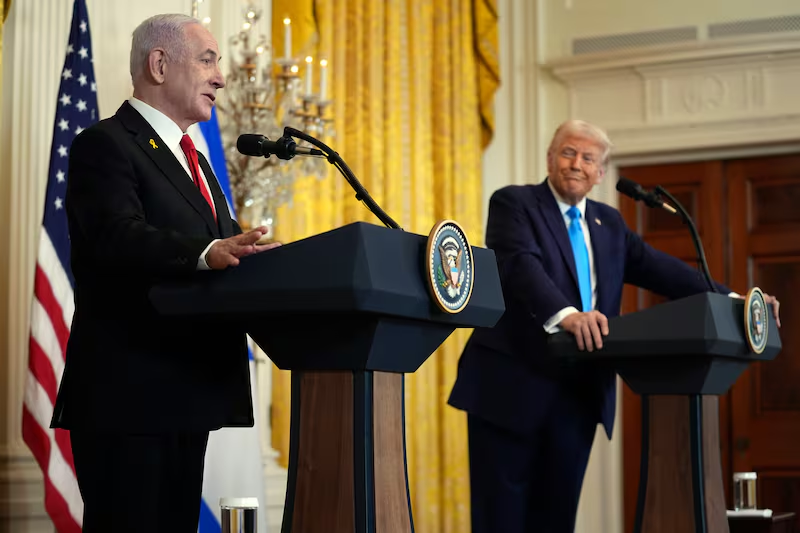When Donald Trump on Tuesday announced his proposal for the United States to take ownership of the Gaza Strip, he shocked even senior members of his own White House and government.
While the US president’s announcement looked formal and thought-out – he read the plan from a sheet of paper – his administration had not done even the most basic planning to examine the feasibility of the idea, according to four people with knowledge of the discussions, who were not authorised to speak publicly.
It wasn’t only the Americans who were scrambling; the announcement came as just as much of a surprise to Trump’s Israeli visitors. Soon before they walked out for their joint news conference Tuesday, Trump surprised Israeli prime minister Binyamin Netanyahu by telling him he planned to announce the Gaza ownership idea, according to two people briefed on their interactions.
Inside the US government, there had been no meetings with the state department or Pentagon, as would normally occur for any serious foreign policy proposal, let alone one of such magnitude. There had been no working groups. The defence department had produced no estimates of the troop numbers required, or cost estimates, or even an outline of how it might work.
READ MORE
[ Trump says Israel would hand Gaza over to US after fightingOpens in new window ]
There was little beyond an idea inside the president’s head.

Unlike major foreign policy announcements with past presidents, including Trump, the notion of the United States controlling Gaza had never been part of a public discussion before Tuesday.
But privately, Trump had been talking about US ownership of the enclave for weeks. And his thinking had accelerated, according to two administration officials, after his Middle East envoy, Steve Witkoff, returned from Gaza last week and described the horrific conditions there.
But nobody – not in the White House, not the Israelis – expected Trump to roll out the idea Tuesday until shortly before he did so. The idea was met with immediate opposition from the Arab world, including from Saudi Arabia, a key US ally. And in comments to reporters Wednesday, White House press secretary Karoline Leavitt tried to soften some of Trump’s statements.
While Trump had questioned why Palestinians would want to return to Gaza after being relocated and suggested the area could become a haven for tourists, Leavitt maintained that Trump simply wanted Jordan and Egypt to take in Palestinians “temporarily.” And she minimised the idea of US financial investment, despite Trump positing a “long-term ownership” interest.
She also said the president had not committed to putting boots on the ground, although Trump had said: “We’ll do what is necessary. And if it’s necessary, we’ll do that.”
On Thursday, Trump took to social media to say that Gaza would be handed over to the US by Israel after the fighting had stopped - negating the need for an American military presence.
It is unclear whether Trump previously discussed the matter in any detail with the Israelis before Tuesday. A spokesperson for the Israeli Embassy did not respond to a message seeking clarity.
[ For Palestinians, Trump’s Gaza Riviera plan is a fate worse than bombsOpens in new window ]
His presentation on Tuesday left more questions than answers, such as: How would this work? What would it cost to rebuild a demolition site the size of Las Vegas? How would seizing Palestinian territory be justified under international law? And what would happen to two million refugees?
In the hours after the announcement, senior administration officials were notably short on substantive answers. The reason for their evasiveness soon became clear: No actual details existed.
On Wednesday, Trump’s national security adviser, Mike Waltz, appeared on “CBS Mornings” to sell the Gaza idea. But it was clear from the conversation that this was less a plan than “concepts of a plan,” as Trump described his ideas for healthcare policy during the 2024 campaign. That plan never materialised.
“The fact that nobody has a realistic solution, and he puts some very bold, fresh new ideas out on the table, I don’t think should be criticised in any way,” Waltz said. “I think it’s going to bring the entire region to come with their own solutions if they don’t like Mr Trump’s solution.”

Trump has been publicly pressuring the Jordanians and Egyptians for weeks to take in people from Gaza, but so far both countries’ leaders have refused. Forcibly removing the Palestinians from Gaza would violate international law, but Trump said in his news conference on Tuesday that he expected they would be eager to leave the land because it was uninhabitable. Perhaps they could return eventually, he said.
He said all of that while standing beside Netanyahu, whose military campaign had obliterated much of Gaza after the Hamas terrorist attacks in Israel on Octber 7th, 2023 – creating the very conditions Trump was referring to.
“The US will take over the Gaza Strip, and we will do a job with it, too,” Trump said. “We’ll own it and be responsible for dismantling all of the dangerous unexploded bombs and other weapons on the site. Level the site and get rid of the destroyed buildings. Level it out.”
Netanyahu, who has been trying to clear Hamas from Gaza since the October 7th massacre of more than 1,200 people, looked pleased as Trump spoke.
Other US officials were less thrilled about the proposal. Two people close to Trump insisted it was his idea alone.
Several senior officials, who spoke on the condition of anonymity to describe sensitive discussions, told The New York Times that they were still trying to figure out the genesis of the idea, and considered it fantastical even for Trump.
The concept is difficult to square with Trump’s criticisms of previous presidents for nation-building in the Middle East. His proposal that America take responsibility for one of the world’s worst disaster zones also came as he was shutting down the primary federal government agency responsible for foreign development assistance, the US Agency for International Development.
But Trump’s impulses have never been as anti-interventionist as the isolationists in his party would like them to be. When the Iraq War began, he initially cheered it before condemning it. In 2011, when he considered running for president, he said the United States should “take the oil” from Iraq, and he has promoted the idea of the US military extracting critical minerals from overseas war zones.
In his second presidential term, he has put his imperialist impulses on display. He has said he wants the United States to buy Greenland, refusing to rule out military force despite the existence of a US base there. He has said he wants to take back the Panama Canal and that Canada should become America’s 51st state. He has said he thinks the United States should be entitled to Ukraine’s natural resources as repayment for all the military aid it has sent to help the Ukrainians defend themselves against the Russians.
Trump views foreign policy as a real estate dealmaker. He has never cared about international law, never lectured autocratic leaders about human rights as other US presidents have done.
Instead, for decades, he has viewed the world as a collection of countries that are ripping America off. He is preoccupied by the question of how to gain leverage over other nations, whether they are allies or adversaries. And he searches for ways to use American power to dominate other countries and to extract whatever he can. Trump does not believe in “win-win” diplomacy; all deals, whether in business or foreign affairs, have a clear winner and a clear loser.
Like Trump, his Middle East envoy, Witkoff, is a real estate developer and investor who has done business in the region. And Trump’s son-in-law Jared Kushner, another real estate investor who worked the Middle East portfolio in his first term, riffed last year about the incredible development opportunities presented by the Gaza waterfront.
Several advisers to Trump said they expected the Gaza ownership idea to die away quietly as it became clear to Trump that it was unfeasible.
But Daniel B Shapiro, who served as the US ambassador to Israel under president Barack Obama, and more recently at the Pentagon, said even just floating the idea risked provoking more extremism: “This is not a serious proposal. The US taking over Gaza, at massive cost in dollars and troops, is about as likely as Mexico paying for the wall or the United States seizing Iraq’s oil.
“The danger is that extremists within the Israeli government and terrorists of various stripes will take it literally and seriously, and start to act on it,” he said. “It could imperil the further release of hostages, put a target on the back of US personnel and undercut prospects of a Saudi-Israel normalisation deal.”
When the Trump team hears warnings like this from former Democratic administration officials, they counter that Obama officials (although Shapiro was not among them) incorrectly warned that the Middle East would descend into violence after Trump moved the US Embassy in Israel to Jerusalem in 2017. They also point out that it was Trump who delivered normalisation agreements between Israel and four Muslim-majority states inhis first term — an effort, known as the Abraham Accords, that the Biden administration tried unsuccessfully to expand upon.
Trump’s Gaza takeover idea delighted many on the hard right in Israel and some within America’s pro-Israel community. The Israeli government has long wanted to seize back Gaza from the Palestinians to ensure that the land cannot be used to launch terrorist attacks against Israel.
David Friedman, who served as Trump’s ambassador to Israel in his first term, was taken by surprise by the announcement but called the president’s idea “brilliant and out of the box creative and frankly the only solution I’ve heard in 50 years that has the chance of actually changing the dynamics in that troubled part of the world.”
Friedman said in an interview that the challenge his team had faced in the first Trump term was that “we never could answer the basic question, which is: Is there anybody who can rule over Gaza that will not be a threat to the people in Gaza as well as to Israel?”
He said it was intolerable for Hamas or the Palestinians who supported it to remain in Gaza. Asked who would live there instead, Friedman said that after 15 years of rebuilding it would be a “market-driven process”.
“I know I’m sounding like a real estate guy,” he said, but he could not help but imagine the possibilities presented by “25 miles of sunset-facing beachfront.”
- This article originally appeared in The New York Times.





















